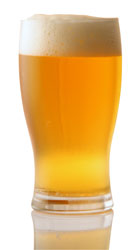
Starter specific gravity?
#1

Posted 20 August 2009 - 05:36 PM
#2

Posted 20 August 2009 - 05:39 PM
#3

Posted 20 August 2009 - 06:57 PM
#4

Posted 20 August 2009 - 07:02 PM
Edited by chuck_d, 20 August 2009 - 07:03 PM.
#5

Posted 20 August 2009 - 08:56 PM
#6

Posted 21 August 2009 - 05:11 AM
And any sugars above 1.040 will just make alcohol, no matter how much you aerate it.... the remaining sugar will just make alcohol.
#7

Posted 21 August 2009 - 07:19 AM
Why's that? If true, that would imply that we wouldn't be able to increase cell count in a batch of beer since they're all above 1.040, and that we've been wasting our time oxygenating full batches.And any sugars above 1.040 will just make alcohol, no matter how much you aerate it.
#8

Posted 21 August 2009 - 06:15 PM
#9

Posted 21 August 2009 - 06:26 PM
#10

Posted 21 August 2009 - 06:41 PM
i have a stir plate and I often make 3000L starters just b/c I can. Def get a 5L flask.The starter needs to be more than a pint.For a 5.5 gallon batch of 1.050 beer, you'd want about 1.75-2L of starter. I'd HIGHLY recommend that if you're going to buy a flask, get at least a 4000mL, especially if you don't have a stirplate. Starters for 5 gallons, without a stirplate, are going to be in the 1500-4000+ mL range.
#11

Posted 21 August 2009 - 07:34 PM
#12

Posted 22 August 2009 - 02:47 PM
#13

Posted 22 August 2009 - 04:18 PM
Gallon jugs work fine, I used to use a glass flower vase from big lots. It was a little tough to get a stirbar to stay in place but it worked here. Eventually a 4L flask showed up uber cheap on craigslist so I bought it. A diy stirplate will really jump up your cell count though - much more than additional volume.I imagine a 5L flask is pretty expensive. How about an old 1.75L glass rum bottle? 5 liters seems like a lot.
Edited by dj in kc, 22 August 2009 - 04:20 PM.
#14

Posted 22 August 2009 - 05:00 PM
+1 I just finished a DIY stir plate and used it to propogate yeasts for 10 gallons of Ofest. A stir plate is optimum for starters for sure. I think a 2L flask works well too especially for a stir plate but when I did simple starters I used a couple gallon jugs sometimes I had to step up the yeast but they worked great anyways. As for the stir plate with a simple starter 17-21 days for a lager fermentation at 50 degrees, Stirplate method 12 days for one batch 14 for the other. I see a difference, stir plates are great.Gallon jugs work fine, I used to use a glass flower vase from big lots. It was a little tough to get a stirbar to stay in place but it worked here. Eventually a 4L flask showed up uber cheap on craigslist so I bought it. A diy stirplate will really jump up your cell count though - much more than additional volume.
#15

Posted 23 August 2009 - 08:06 AM
I am going to take exception on the use of the word "need."Yes, your are better off making a starter than not making a starter, when using liquid (not dry) yeast.IMHO make as big of a starter as is practical for your situation.Alternate solution: buy a second vial (or smackpack) and pitch themYou can read up and go to few web sites that will tell you what is optimum. Hare is a calculator I find useful: https://www.wyeastla...b_pitchrate.cfmDo not equate not less than optimum with making bad beer. People make great beer despite doing all sorts of things "wrong."[edit] My observations say to go easy on the OG 1.030 to 1.035 is fine. Your are growing yeast, not making beer.My universal homebrewer forum advice. "Do the best you can with the resources available to you."zymotThe starter needs to be more than a pint.For a 5.5 gallon batch of 1.050 beer, you'd want about 1.75-2L of starter. I'd HIGHLY recommend that if you're going to buy a flask, get at least a 4000mL, especially if you don't have a stirplate. Starters for 5 gallons, without a stirplate, are going to be in the 1500-4000+ mL range.
Edited by zymot, 23 August 2009 - 08:20 AM.
#16

Posted 23 August 2009 - 03:40 PM
I make all of my starters with 100g of DME per L of H2O.OK another question (I'm starting to like this forum)I'm going to brew a batch in a couple days (an Irish Red) and I want to do a starter this time. I've never done one before. Is it necessary to do some calculations to make sure the starter specific gravity will be the same as the wort? Does this make for an easier transition? Or should I just do a 1/2 cup DME in a pint of water? Thanks
#17

Posted 23 August 2009 - 03:54 PM
Whoever gave me the heads up on that ratio has made my life a little easier...........I make all of my starters with 100g of DME per L of H2O.
#18

Posted 24 August 2009 - 08:24 AM
Yeast evolved to ferment drops of juices that dripped from rotting fruit. They have a survival mechanism where, if they see a high-gravity sugar solution, they produce alcohol first to inhibit other, less-alcohol tolerant microbes, then they start growing. It's not like flicking a switch where you only get alcohol from OG to 1.040, then you only get cell growth from 1.040 down to 1.008, it's much more of a gradual shift -- more alcohol is made at high gravities, more cell growth occurs at low gravities, but alcohol and cell growth both always occur.1.040 is often used as a convenient OG that trades off cell growth and volume of starter.There are also other issues around low gravity starters and high gravity beers. If you make a really high gravity beer, you need highly alcohol tolerant yeast to avoid a stuck fermentation. Yeast that were grown in a low-gravity starter have more reserves of the chemicals required for alcohol tolerance, while yeast grown in a high gravity starter will have already used up most of those reserves.Why's that? If true, that would imply that we wouldn't be able to increase cell count in a batch of beer since they're all above 1.040, and that we've been wasting our time oxygenating full batches.
#19

Posted 24 August 2009 - 08:24 PM
I've not heard it described this way before, but I don't doubt it. Regardless of what caused this evolution in yeast, it basically works like this (this is my short translation of one of Dr. Graeme Walker's lectures on yeast metabolism) As most of us already know, yeast go through 2 seperate catabolic phases- respiration and fermentation. During RESPIRATION, wort sugars are converted into co2 and water. The o2 intake generates large amounts of energy and a new yeast cell is formed. During FERMENTATION, the sugars are converted into co2 and acetaldehyde (which then turns into ethanol). The goal with a starter is to give the yeast the ideal environment to keep it in respiratory mode to create as much new yeast as possible. This means controlling o2 and glucose levels.What's often overlooked by stir plate crazy brewers, is that having low sugar levels is even more critical than keeping o2 levels high. Even with o2 present, high glucose concentrations will inhibit the yeasts ability to respire. This is called the Crabtree Effect. I've not found a specific number telling what gravity causes yeast to force ferment, but I do know as long as there is sufficient glucose and o2 available (1.030 - 1.040 seems to be the recommended target), having 'more' glucose only inhibits yeast growth.The best way to propagate yeast is to have an automated system measure DO, glucose and yeast nutrients and keep a continuous flow of all 3 as needed. I can't wait to build one of those!Yeast evolved to ferment drops of juices that dripped from rotting fruit. They have a survival mechanism where, if they see a high-gravity sugar solution, they produce alcohol first to inhibit other, less-alcohol tolerant microbes, then they start growing. 1.040 is often used as a convenient OG that trades off cell growth and volume of starter.
#20

Posted 24 August 2009 - 08:30 PM
0 user(s) are reading this topic
0 members, 0 guests, 0 anonymous users

















